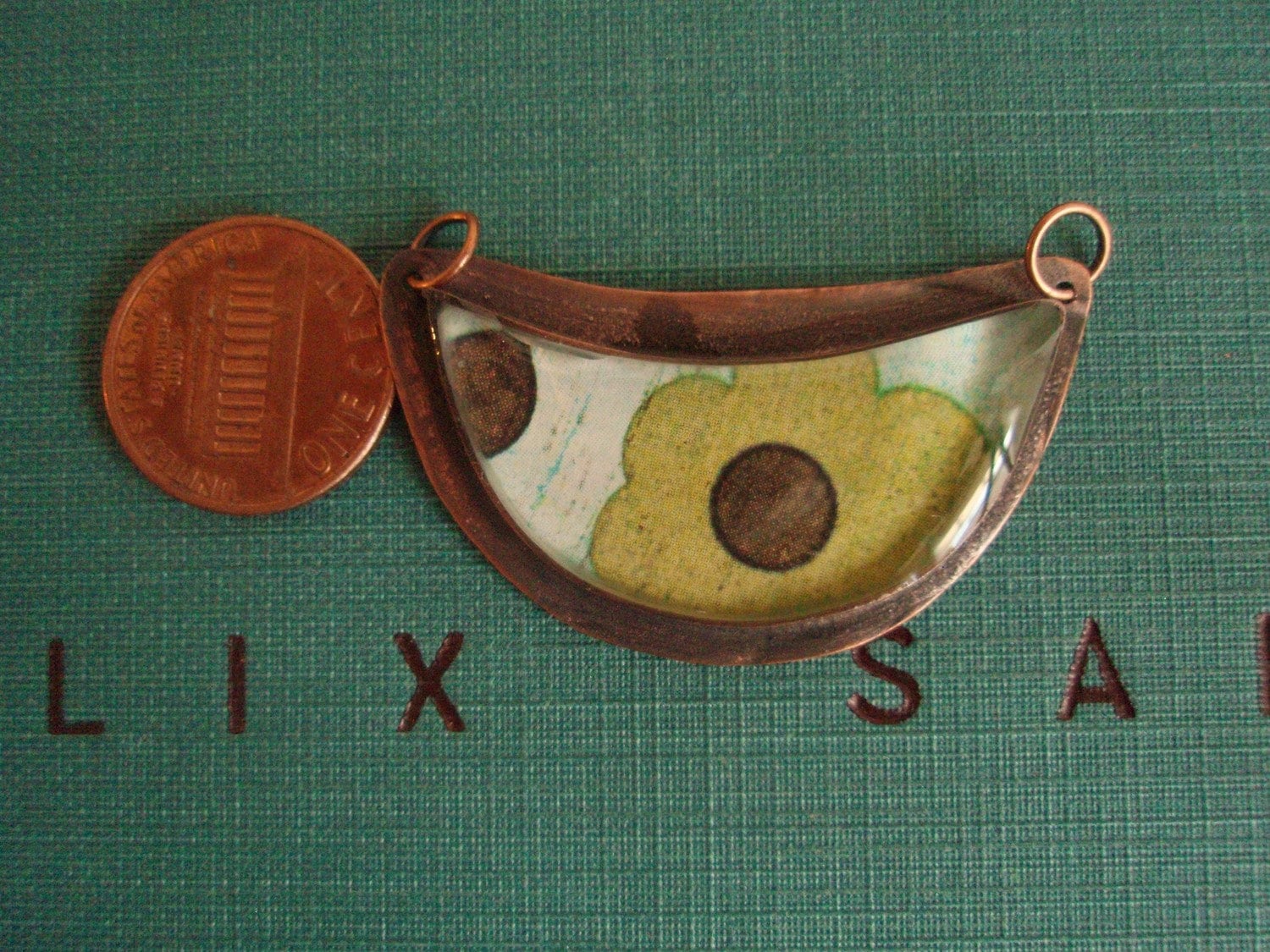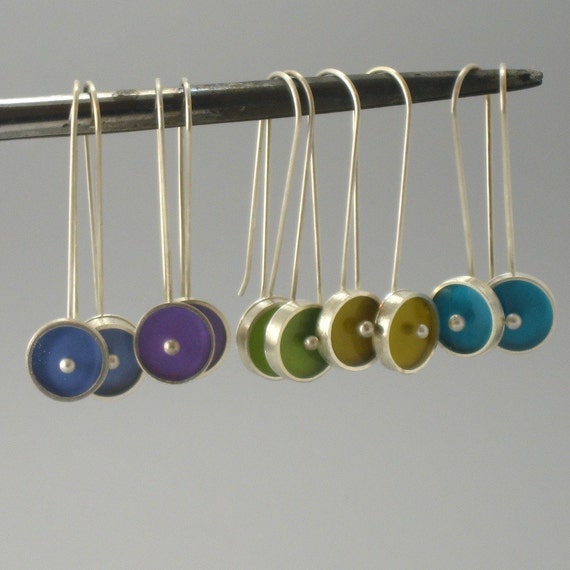So, you've been practicing your even count peyote stitch, right? Because in this tutorial, I'm going to go over a few basic materials and then show you how to use some easy bead embroidery techniques to make a beaded bezel for a (handmade) cabochon.
The first thing that you'll need is a cabochon (preferably handmade!), glue, some cylinder beads, a piece of bead embroidery backing or medium, some beading thread, and a beading needle. I have a few recommendations for each of these:
- Cylinder Beads - I always recommend stitching a peyote bezel with cylinder beads, since they are relatively uniform in shape and size. Size 11 works best for this technique, but if you're really nuts, you can use a smaller size 15.
- Bead Embroidery Medium - This is what you will glue your cabochon to. I prefer to use Lacy's Stiff Stuff because it's easy to stitch through, easy to cut, and can be dyed any color you like using regular fabric dye. There is also an alternative bead embroidery foundation that is very similar to Lacy's (but much less expensive) available from Sova Enterprises.
- Beading Thread - While I love stiffer threads like FireLine and WildFire for most other beadwork, I still prefer to use a softer nylon thread for bead embroidery. My favorites are Nymo and S-Lon - they are inexpensive, come in a huge range of colors, and are widely available at bead shops and online.
- Glue - What kind of glue you use doesn't really matter, since you will be stitching a very secure bezel around your cabochon. But to hold your cabochon in place while you stitch, I prefer E-6000. Always make sure that you follow the package directions when using glues!
- Beading Needle - Size 12 beading needles work the best for bead embroidery. You can either use a longer 2" needle, or a shorter or "sharps" needle. Whatever is more comfortable for you is the best thing to use, but make sure it's a beading needle - beading needles were designed to fit through tiny seed beads several times without breaking the needle or the bead.
Now that you have everything you need, let's start stitching!
1.
Glue the cabochon to the bead embroidery medium. Use a toothpick and spread a thin layer of glue evenly on the back of your cabochon. Firmly press the cabochon onto the bead embroidery medium and wipe away any glue that oozes out from under the edge with a toothpick or a tissue. Allow one hour for the glue to dry completely. At this point, you might want to trim down the piece of bead embroidery medium to a more manageable size. I usually leave anywhere from 1 to 4 inches around the cabochon to give myself room to add more rows of bead embroidery.
2.
Basic Beaded Backstitch. To do basic beaded backstitch:
- Cut a comfortable length of beading thread, and tie a small knot about 1 inch from the end. Pass the needle up through the bead embroidery medium near the edge of the cabochon.
- Pick up 2 cylinder beads and push them down against the embroidery medium. Pull on your thread a little bit, and pass your needle down through the embroidery medium at the edge of the second cylinder bead.
- Flip your embroidery medium over and look at the back. Estimate the point between the two beads you just added, and pass your needle back up through the embroidery medium at that point. You should come up between the two beads. (Or roughly near that spot.)
- Finally, pass your needle through the second bead you added and pull snugly.
3.
Continue to add more beads. Using the basic beaded backstitch, add a ring of beads all around the cabochon, but make sure that there are an even number of beads surrounding the cabochon. If you need to squeeze in an extra bead to make it an even number, you're better off having a few extra beads than having too few. Once the ring of beads is finished, pass your needle through the very first bead you added.
4.
Start stitching in peyote stitch. Now you'll use those even count peyote stitch basics! Pick up a bead, skip the next bead in the ring, and pass through the next bead. Pull snugly so that the beads line up on top of each other. Continue to do this all the way around the ring.
5.
Making the step up. When working in tubular even count peyote for this bezel, after you've added all your beads for the first round, it will look like you don't have anywhere left to go. At this point, you'll make the "step up" by passing your needle through the first beaded you added at the beginning of the round. As you get more confident with each round, DON'T try to add the last bead and make the step up at the same time - you'll most likely end up piercing your beading thread with your needle and you'll create a weak spot in your bezel.
6.
Stitching the rest of the bezel. How many rows you need to finish the bezel depends on how tall the cabochon is. For a cabochon with a straight edge, you will probably need five or 6 rows. For a domed (rounded) cabochon, you may only need three or four rows. A good rule of thumb is that once your bezel starts to curl inward around your cabochon, you are probably done.
7.
Add an extra row of smaller seed beads for security. For the very last row of your bezel, use size 15 seed beads and pull snugly with each stitch. This will give your bezel a little extra security around the cabochon. You can also use beads of a contrasting color to add a little extra "pop" to your beaded bezel!
To finish your cabochon, you can add one or more rows of bead embroidery (beaded backstitch) around the bezel. You can get as fancy as you want, or just add a single row of larger (size 8 or 6) seed beads. Again, play with colors to see what you like. You can use colors in the same family, or use something wildly different for visual interest. For this piece, I decided to add a row of Picture Jasper rounds that picked up some of the colors in the handmade Lisa Peters Art ceramic cabochon.
I hope you've enjoyed this tutorial! This is a sneak peek from the book I'm working on, to be self-published, that will be all about turning handmade cabochons into beautiful, personal beaded jewelry. (I still need a good title, so if anyone has any suggestions, let me know!)
Next week, I'll show you how to add a backing to your cabochon to turn it into a pendant, brooch or bracelet. And if you're really interested in bead embroidery, make sure you enter our giveaway to win a copy of bead embroidery master Sherry Serafini's newest book, "Sensational Bead Embroidery". Happy beading!

 A Wholesale Body Jewelry Shop should have certain basic qualities and trust factors to be able to win the confidence of the customers with its policies. As a customer, what you would want first would be quality.
A Wholesale Body Jewelry Shop should have certain basic qualities and trust factors to be able to win the confidence of the customers with its policies. As a customer, what you would want first would be quality. As a piercing jewelry remains directly attached to your body, and in most case through raw flesh or skin, it is essential for the jewelry material to be made of good quality material. The next thing that matters is the delivery process, for this is how you will get your orders. If the delivery process is slow or unreliable, the whole experience might become a mess, and you might as well lose confidence from online shopping.
As a piercing jewelry remains directly attached to your body, and in most case through raw flesh or skin, it is essential for the jewelry material to be made of good quality material. The next thing that matters is the delivery process, for this is how you will get your orders. If the delivery process is slow or unreliable, the whole experience might become a mess, and you might as well lose confidence from online shopping. As for the metals or materials of the body piercing jewelry, make sure that you do not buy anything that is made in nickel, for it is a highly harmful metal as far as body jewelry is concerned.
As for the metals or materials of the body piercing jewelry, make sure that you do not buy anything that is made in nickel, for it is a highly harmful metal as far as body jewelry is concerned. The reliable metals are usually gold, silver, titanium, platinum. Other than these, there are variations of materials, like wood, stone, anodized jewelry in black or gold. Anodizing means to put thick layers of the anodizing metal over the base metal, this gives not just a sophisticated look but also makes the polish stay for a long time.
The reliable metals are usually gold, silver, titanium, platinum. Other than these, there are variations of materials, like wood, stone, anodized jewelry in black or gold. Anodizing means to put thick layers of the anodizing metal over the base metal, this gives not just a sophisticated look but also makes the polish stay for a long time. 







































